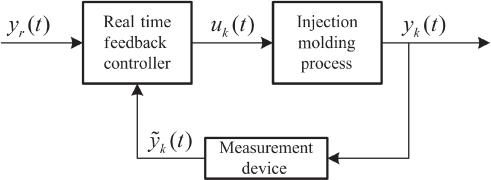Chapter 12: Feedback Control
The control strategies for injection molding process are evolving with the development of batch process control theory and control technology. In general, the control algorithms for injection molding can be categorized into two types: control strategies based on feedback and learning control strategies. The learning control strategies will be introduced in Chapter 13. In this chapter, the control strategies based on feedback, including traditional feedback control and advanced feedback control (such as adaptive control, model predictive control, optimal control, and intelligent control strategies), are introduced in detail with the examples of some key molding variables control applications.
12.1 Traditional Feedback Control
The traditional feedback control refers to the control that the controller parameters are determined using classical design methods, and the controller only depends on the real time process measurements, as shown in Figure 12.1.
Figure 12.1 Block diagram of traditional feedback control scheme.

The purpose of such kind of control is to keep the process variable close to the set point in spite of ...
Get Computer Modeling for Injection Molding: Simulation, Optimization, and Control now with the O’Reilly learning platform.
O’Reilly members experience books, live events, courses curated by job role, and more from O’Reilly and nearly 200 top publishers.

